
|   |

|   |
Diksha: A tribute to Muthuswamy Dikshitar - Purnima Gururaj October 8, 2013 Bengaluru Gayana Samaja welcomed its patrons and lovers of art on September 27 to an aesthetically decorated stage with Saint Poet Muthuswamy Dikshitar adorning a wood carved doorway flagged by beautiful pillars. The scene was set for Diksha, a dance production conceptualized by art consultant Usher RK and presented by the G Seshappa and Sunderamma Charitable Trust. The evening opened with a brief introduction by Usha followed by the lighting of the lamp and a welcome address by Radhakrishna Seshappa. Sadashivam, a direct descendent of Muthuswamy Dikshitar spoke briefly but in depth on the life and works of Dikshitar. The evening’s presentation was new choreographies set to well known kritis of Dikshitar. The performance began with an opening piece inspired by the western band music and their notes based on which Dikshitar created close to 40 compositions called “nottuswarams.” The Samskruti female dance ensemble Chaturagamini directed by noted dancer Sathyanarayana Raju presented “Shakti sahita ganapathi,” a short krithi followed by “Sri Mahaganapathim ravatumaam” in raga Gowla. Subtle aharya and graceful movements that explored all attributes of Ganesha was a fitting opening to the evening’s presentation. Padmini Upadhaya was acknowledged for assisting with the choreography of the piece. The individual dancers were Aditi, Gowri, Pruthvi and Anju. 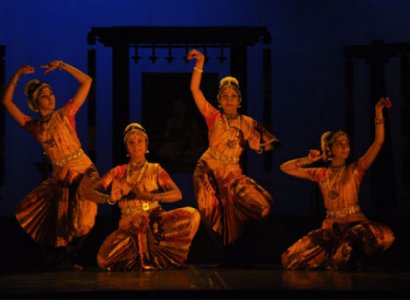 Chaturagamini 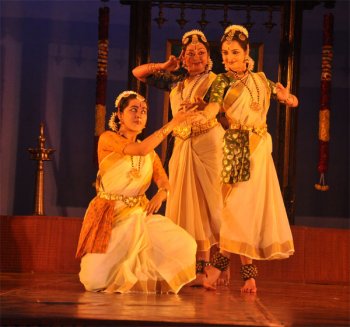 Rasika ensemble The unique opening of the next piece to the arohanam and avarohanam of raga Kamala Manohari, with the apt use of the alapadma hasta created a mild curiosity and excitement at what was to follow. “Kanjadalayadakshi” in praise of Goddess Kamakshi was presented by the Rasika ensemble, choreographed creatively by Kiran Subramanyam. The visualization of the lotus in describing the eyes and face of the goddess was visually entrancing as the lotus passed from one hand to the other effortlessly between the three dancers. Nadais were used effectively in straight lines, diagonals and circles in the phrase “Kunjaragamane.” One could sense the omnipresence of the goddess in the encompassing movement of the artistes. The Rasika ensemble included Shivaranjani, Divyaranjini and Bhavani. “Sri Rangapura Vihara” in ragam Brindavana Saranga and set to roopka tala created a dichotomy of senses. Sitting in the audience one wondered whether to listen to the voice of MS Subbulakshmi boom in your head as Srivatsa sang or watch the neat delineation of the same by senior performer Poornima Ashok. The sthala mahima of Srirangam was expanded on as a sanchari bhava. 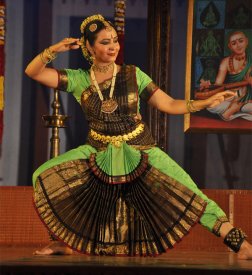 Poornima Ashok 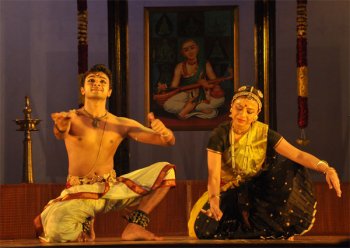 Parshwanath Upadhya and Preeti Sunderrajan Parshwanath Upadhya and Preeti Sunderrajan, equally matched in boundless energy, presented “Sooryamurthe” in raga Saurashtram and dhruva talam. Their quiet entry was a deep contrast to the rest of their presentation, the only downside being separate sancharis that looked hurriedly composed. The entries and exits were effective, consistent and apt. “Sadachaleshwaram” in raga Bhoopalam to adi talam was a unique experiment on the part of Usha. Three young talented male dancers were picked from different dance schools in Bangalore and brought under the umbrella of Kiran Subramanyam’s choreography, which was fresh and highly demanding of the dancers who executed the piece with utmost confidence, without missing a beat of the highly complicated rhythms patterns. However what struck in the mind long after leaving the show was the effective use of hastas to depict deeply philosophical concepts like turning water into ghee, or the Lord being the pravaha (flow) of amritha (nectar) of chidananda (bliss). The three male dancers were Anil Iyer, Madhuchandra and Mithun Shyam. The music and the dance became one as Srivatsa began “Akhilandeshwari” in raga Dwijawanti to adi talam. The quiet yet creative arudhi and a clean rendition of the padabhava of the song were highlights of this medium paced song which poses a challenge to the dancer in terms of holding the sthayi of utmost surrender and bhakti. The piece was effectively presented by Soundarya Srivatsa. The increasing level of challenge came to a crescendo in the grand Chaturdasa ragamalika “Sri Viswanatham bhajeham” set in fourteen ragas. It is interestingly split in two parts symbolising the chaturdasa bhuvanas or fourteen worlds as mentioned in the puranas. Structured wonderfully, the first six ragas from Sriragam to Mohanam continue in reverse order for half avarthanam each linking back to the pallavi in Sriragam. The second part starts with raga Sama and continues with seven other ragams ending with Bhoopalam. These also tie back to the pallavi proceeding in reverse order in half avarthanams. The quiet fortitude and the meditative quality in dancing was a definite need to pull off a piece of this magnitude. Sathyanarayana Raju was the apt choice for the presentation of this piece. Graceful movements and varied poses of Shiva, quiet adavus, one here and one there only when necessary created ample scope for the viewer to enjoy the complexity of the music while feeling the presence of Lord Vishwanatha himself. 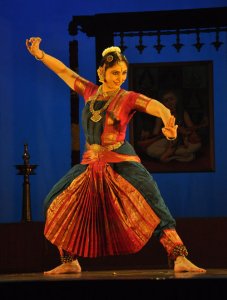 Soundarya Srivatsa 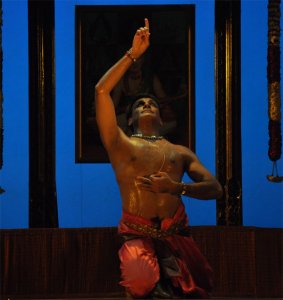 Sathyanarayana Raju A natural progression after being in the presence of the almighty was the joyous Tillana, a composition of Kiran Subramanyam, in raga Rasikapriya set to adi talam. It abounded in rhythmic complexity and energy, a fitting ending to a fulfilling evening. Accompanying the artists on the music ensemble were Kiran Subramanyam, Shakuntala Prabhat and Ramya on the nattuvangam, DS Srivatsa on vocal, Lingaraju on the mridangam, Vivek on the flute and Shankarraman on the veena. Purnima Gururaj is a Bharatanatyam dancer/teacher based in Bangalore. |